This article is being co-posted on Maple Leafs Hotstove as well as on my own site, www.originalsixanalytics.com. Find me @OrgSixAnalytics on twitter.
All season long, Toronto fans have been talking about Steven Stamkos. It is well known that Stamkos will be an unrestricted free agent (UFA) this July. This means that – you guessed it – Steven Stamkos could become a Leaf.
Naturally, if it happens, many fans have presumed ‘Stammer’ would be named captain, immediately become the face of the franchise, and lead the Leafs through its centennial season and beyond.
As a result, many have also asked the question, “what is Steven Stamkos really worth?” Assuming he reaches UFA status, what will it cost the Leafs to sign him? Does he deserve the same type of money as Kopitar, Kane, and Toews? Back in January, Ryan Kennedy over at The Hockey News made some reasonable comparisons and suggested that he sees Stamkos as being worth roughly ~$9M in AAV. Full credit to Ryan – as that was earlier in the season and a somewhat different situation – however, in this article I will argue that it is extremely unlikely that any team, Toronto included, will be able to sign Stamkos for an AAV of less than $10M, or for much less than the maximum term of 7-8 years.
Before getting into the approaches to valuation, let’s look at some of Stamkos’ key statistics to understand exactly how he adds value.
Stamkos’ Goals Above Replacement (GAR)
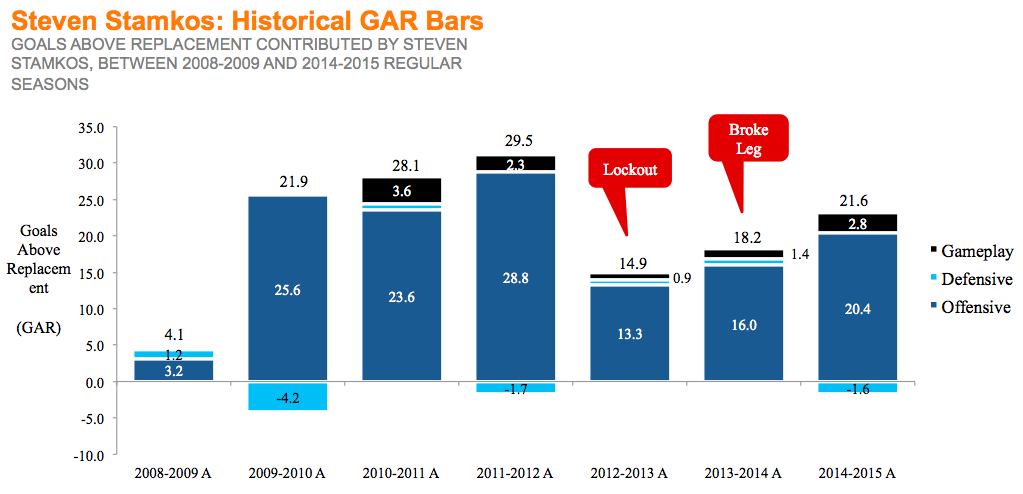
(If this data doesn’t mean much to you, I recommend you check out my summary of the practical applications of Goals Above Replacement)
For individual player analysis, GAR (Goals Above Replacement) can be a useful starting point to illustrate the big picture. Looking at Stamkos’ GAR shows us:
- He performs at an elite level, hitting 15-20+ GAR all but his rookie season, something done in fewer than ~6% of all player-seasons.
- Stamkos contributes value to his team almost entirely through his offensive play:
- 95% of Stamkos’ career GAR comes from his offensive ability, approximately 2/3rd of which coming from his shooting percentage (15.2% at 5v5) and 1/3rd from his impact on shot-rates (Corsi For).
- At times over his career, Stamkos has been a slight defensive drag to his team – but ultimately he is a relatively neutral contributor in non-offensive areas.
- As noted in the chart, Stamkos’ 2012-14 results may not be indicative of his capability as the seasons were impacted by the lockout and his broken leg, respectively.
We likely didn’t need GAR to tell us any of the above, as many would know most of this from simply watching Steven. However, GAR will be important to keep in mind for when we estimate Stamkos’ value later on.
WARRIOR Chart
Next, I have copied Domenic Galamini’s WARRIOR chart of Stamkos, showing Steven’s relative performance within the league on a number of metrics. For those not familiar with WARRIOR charts, Dominic provides a great summary here.
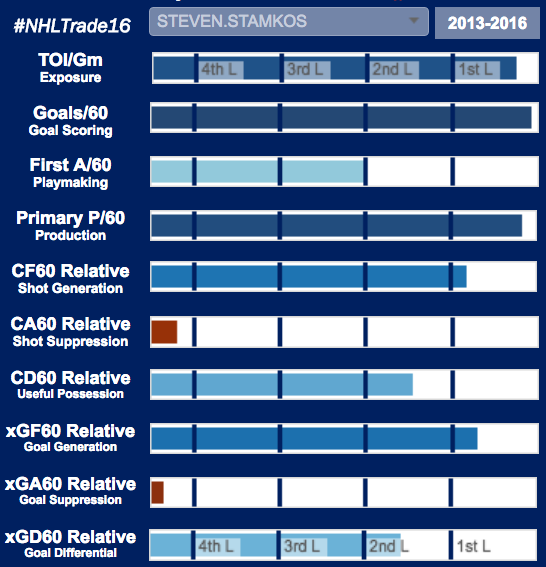
Looking at this chart confirms the following:
- Stammer is an elite scorer and a solid playmaker, scoring very high on Goals/60, Primary Points/60, RelCF60 and RelxGF60.
- Stamkos should not be considered a two-way forward: his defensive contribution is sub-par, as shown by his shot/goal suppression (CA60Rel/xGA60 Rel).
- As a result, when valuing Stamkos, we should be comparing him to similar elite shooters (e.g. Ovechkin, Kane, Perry), as opposed to the leagues’ finest two-way forwards (e.g. Toews, Kopitar, Bergeron).
Given that elite shooters don’t always excel at driving 5v5 CF%, it will be important to keep in mind shooting percentage and powerplay results when comparing Stamkos to other players.
Before we get into valuing Stamkos, let’s quickly look at the qualitative side of the equation.
A Note on Intangible Factors
Although the hockey analytics community tends to discount ‘intangible’ factors, I personally consider them very meaningful. Consider: If you have two players with similar stats, would you pay more for the driven, hard-working guy, high-character guy, or the player who demonstrates none of these traits?
We all know Steven Stamkos is a strong leader. He captained his team to game six of the Stanley Cup Final last season. He also has an incredible work ethic; he is well known for his rigorous offseason training with Gary Roberts. While these strong intangibles are difficult to quantify, they still should play a meaningful role in justifying a premium valuation for Stamkos. But first – what aspects can we quantify?
Approaches to Financial Valuation
In the world of corporate finance – buying and selling companies – great effort is spent attempting to value the businesses being acquired. Generally speaking, there are two approaches:
- Relative (market based) valuation methods
- Intrinsic valuation methods
Let’s start with relative valuation methods.
Market Based Valuation: Comparable Company Player Analysis
For investors, ‘comparable company’ analysis is a key aspect of any deal. The valuation multiples of companies across an industry (e.g. ‘Enterprise Value / Earnings’) set the baseline for determining what the price should be for a similar one. As many readers will know, the exact same approach is often applied to players. We can look at a set of comparable elite shooters to help derive a benchmark for Stamkos’ market value. Keep in mind relative valuation methods like comparables tell us what others are willing to pay for an asset (the market), not necessarily the inherent or ‘true’ value of it.
Using Corsica’s Similarity Score feature, focused specifically on Stamkos’ most important stats (e.g. G/60, P/60, Sh%), I have arrived at the following set of comparables. All players listed below had a similarity score of at least 85% with Steven. I have also tried to present this similarly to how it is done in finance:
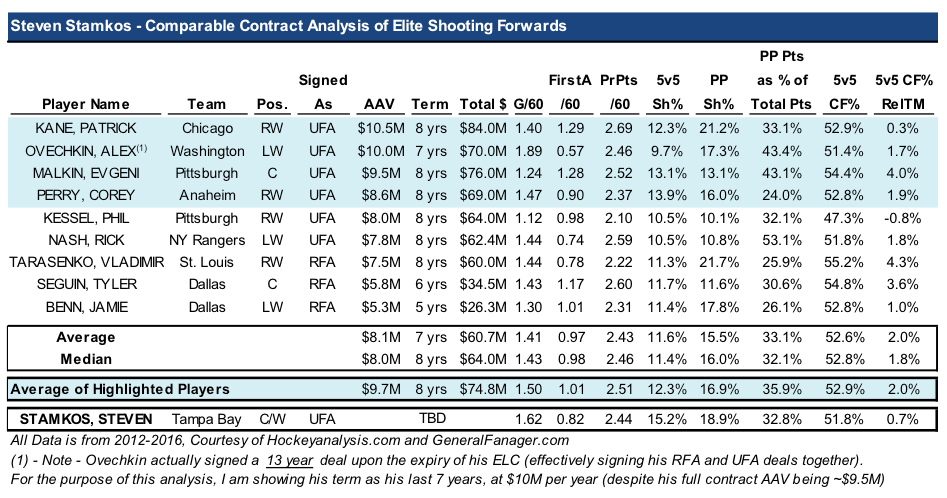
(Note: All data shown is all situations, except where specifically noted)
As you can see, few players in the league score goals and contribute primary points at the same rate as Stamkos. Compared to this set as a whole, Stamkos outperforms the group average for all metrics listed, except for the Corsi stats and FirstA/60.
However, for this analysis to truly be relevant, we can only really compare Steven to players in the same free agency situation when signing, i.e. UFAs. As such, I have highlighted the four UFA players that I consider as having the most comparable performance statistics to Stamkos: Patrick Kane, Alexander Ovechkin, Evgeni Malkin, and Corey Perry. I have also shown their four-player average at the bottom of the table. As you can see, Stamkos is neck and neck with these players in every metric.
In terms of dollars, these four players averaged an AAV of $9.7M, and had an average term of the maximum 8 years. Considering that these players are also not historically known for their exceptional leadership qualities – which Stamkos has in spades – you can begin to see the case for Steven to be earning $10.0M-$10.5M+ per season.
Intrinsic Valuation Methods
In financial markets, the other approach to valuation is using ‘intrinsic’ methodologies – e.g., trying to derive what is a company is worth in an absolute sense. When valuing a company, this is based on the discounted ‘present value’ of a company’s future cash flows – how much money a company will generate cash for its new owner in the future.
My view is that the best ‘intrinsic’ player valuation method available based on public stats is using GAR, which I introduced at the beginning. The first approach I will use is valuing a player based on his historical GAR score, which I have shown previously. The second is a new approach wherein I will show a high-level attempt to forecast a player’s future GAR and use that to derive what he should be paid. When we have confidence in a forecast for a player — which I won’t necessarily say about my own Stamkos GAR forecast today — forward-looking analysis will be the most ‘pure’ measure we can use in valuation.
Historical GAR
First, I will plot Stamkos on the Fair Market Value curve in order to see what he is worth based on what he has done historically. Typically I would encourage using a 3-year average GAR; however, due to the issues of the lock-out season and Stamkos’ injury, I will instead use his career average (ex-rookie season) GAR of 22.
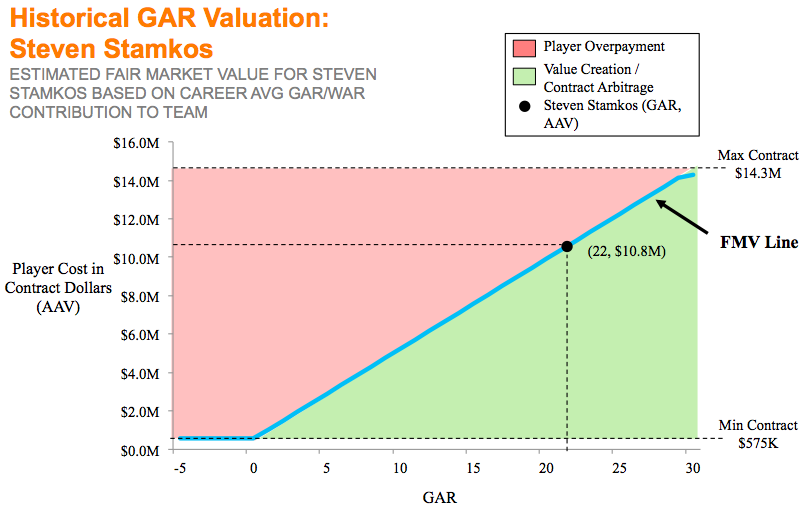
Looking at this chart shows:
- Stamkos’ career Avg GAR/season of 22 values him at $10.8M in AAV.
- However, historical GAR will tend to over-estimate a player’s value, as it is backward-looking and does not adjust for how players decline with age.
- As such, though this is a useful data point, we should take it with a grain of salt.
Forward-Looking GAR: A High Level Estimate
To truly estimate a company’s, or players’, intrinsic value we need a forecast of how it/he is going to do in the future. Of course, like any prediction, this type of estimate is inherently flawed and almost never is how reality actually plays out. However, creating a forecast can help us to see some reasonable scenarios of how Steven might perform in the future. To do this, I will combine his past performance with the aging curve of a typical NHL forward.
Fortunately for us, part 2 of Moneypuck’s Building a Contender Series has an excellent chart that summarizes the league-average GAR aging curve for forwards (is anyone tired of me referring to this series, yet?):
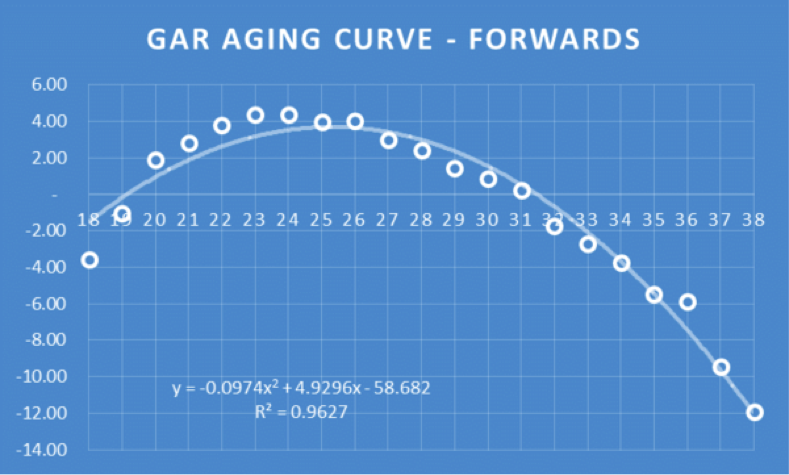
In order to connect this to Stamkos’ expected performance, I will use a rather blunt methodology of simply applying the same absolute value of decline in GAR score showed here to ‘extend’ forward Stevens’ historical performance. The most accurate way to do this would likely be to base Stamkos’ long-term decline on how his comparables declined at the same age. However, for the purpose of brevity, I will use this simplified approach to help illustrate the methodology.
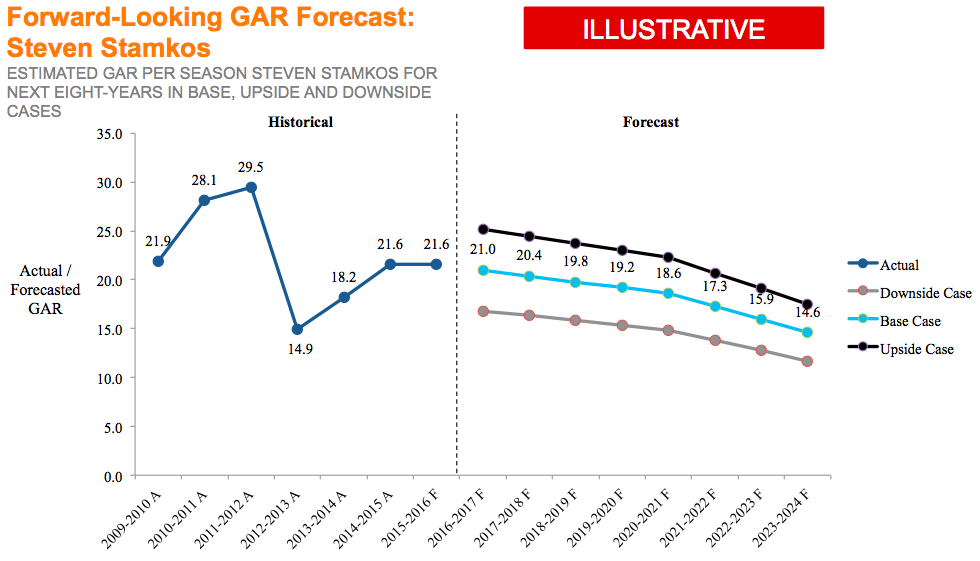
In the chart above I did the following:
- Extended the ‘historical’ performance by one year in 2015-2016, assuming his current season is comparable to 2014-2015.
- Starting at Stamkos’ current age of 26, I applied the absolute decline from Moneypuck’s chart to Stamkos in five and three year chunks.
- (As you can see, the projection begins to decline more quickly after 2020-2021F)
- Last, I adjusted this ‘base’ case by +20% and -20% to create illustrative upside and downside cases.
Although this is a very high level estimate, I think this gives an interesting, basic idea of what we could expect from Stamkos over the next eight seasons. What does this equate to in terms of dollars? The base case results in an average GAR per season of 18.3, equating to $9.1M per year in AAV. The downside and upside cases each average GARs of 14.7 and 22.0, respectively, coming out at AAV values of $7.4M and $10.8M.
Sizing it all Up
Let’s stack these all up next to each other:

Naturally, looking at a wide range of methods gives a wide range of potential values. However, all three of these approaches can be used to justify a valuation for Stamkos at $10.0M+ of AAV. There is also every precedent for him to get the full 8-year maximum term, or 7 years with the Leafs (in the case of a UFA signing with a new team). We can all be sure Stamkos’ agent is well aware of all of these approaches and will be pushing for the high end, trying to secure as much as possible for his client.
Practicalities of the Leafs’ Negotiation Position
Much like in valuing and buying/selling companies, you can do as many fancy calculations as you want but something is ultimately worth what someone is willing to pay for it. Given that Stamkos is a UFA, he is essentially able to auction his contract to the highest bidder – putting all of the power in his hands. This power dynamic, combined with the prior valuation approaches, gives me strong reason to believe Stamkos deserves $10M+ and teams should be willing to pay it, if they have the cap space available.
I’m sure some readers will point out that Stamkos’ basic counting stats (goals/assists/points per game) have declined in the past two seasons, which may be a red flag for the future. Travis Yost and Stephen Burtch both addressed this somewhat, arguing that his quality of teammate and usage are both factors that may be impacting his performance. However, in terms of the value he commands, the strength of his negotiation position will ultimately rule the day. If teams want him, it will take big dollars to get him – either they will be willing to pay for an elite player, or they will not – and I suspect there will be at least one team left standing at a double-digit AAV.
Conclusion
In the end, I know Leafs fans will continue to argue that Stamkos wants to come home, and that maybe he will take a hometown discount to join the Leafs. Although this is possible, in reality the Leafs should not be expecting to walk into a bargain contract with Stamkos. He is an elite scorer, a strong leader, he deserves a top dollar contract, and I strongly believe there will be a team willing to step up and give him the $10M+ per season he commands. Stamkos is entirely worth that amount, and he is an excellent candidate to lead this young Leafs’ team through their centennial season, and seven more after that. All us fans can do now is sit and wait.
Your move, Lou.


































